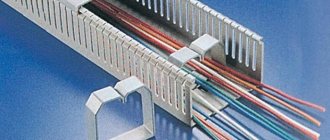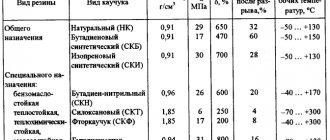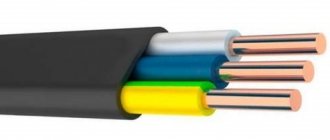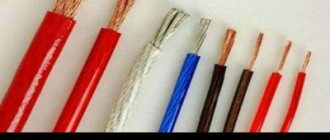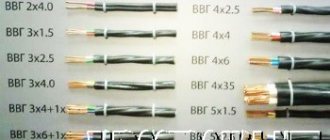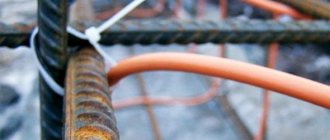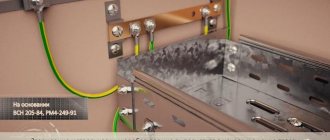Home » Electrical wiring » Wires and cables » KSPV cable
KSPV cable is a signal conductor that is used to deliver an electrical signal to consumers. As a rule, it is used to connect alarm systems and use them in communication and communication systems. In this article we will make a detailed review of the conductor, recall its main technical characteristics and talk about its scope.
Decoding
The KSPV cable received the following abbreviation:
- K – cable.
- SP – designed for transmission systems.
- B – has a vinyl shell.
The cable is actively used during the installation of fire and security alarms. Its popularity is due to its fairly low price and acceptable characteristics.
Let's pay attention! The KSPV cable is an analogue of JY (St) Y Lg and J-YYBd. But these conductors have a higher cost, so it is better to use our conductor now, especially since it is in no way inferior in its main characteristics.
KSPV cable is the best conductor for security systems
The KSPV cable is a conductor that ensures the delivery of an electrical signal to the end user. It is used to connect communication and messaging systems, data processing, as well as security and fire alarms. This wire is the Russian analogue of the JY (St) Y Lg and J-YYBd cable. Most often it is used when laying an internal stationary network, operating voltage is up to 250 V.
The abbreviation KPSV has the following decoding: “K” is a cable, “SP” is a transmission system, and “B” means that the product is covered with a vinyl sheath. The leading manufacturers of this product are Pskovkabel, Kolchuginsky plant, Energakabel and Sevkabel.
Conductor Specifications
Inside the cable there are from 2 to 20 conductors made of copper, and sometimes of aluminum (a conductor with copper conductors is more popular, since copper is more flexible than aluminum and has high conductivity). Each core is protected by polyethylene insulation, and the cable is additionally covered with a polyvinyl chloride sheath. All this ensures the safety and reliability of the wire.
Copper conductors come in four diameters:
- 0.4. With this diameter, the resistance should not exceed 148 Ohms per 1 km, the insulation resistance is 6500 mOhms.
- 0.5 – 94 Ohm.
- 0.64 – 58 Ohm.
- 0.8 – 36 Ohm.
One of the reasons for the popularity of this brand of cable is its high efficiency. Thus, its minimum bending when laying is 10 conductor diameters. This flexibility makes it possible to bend the wire up to 15 times, if the bending angle does not exceed 90 degrees.
Another important characteristic of KSPV is its resistance to changes in ambient temperatures. The wire can be used at temperatures from -40 to +60 degrees Celsius, permissible humidity is no more than 98% at temperatures up to +35.
Installation of this cable is possible both indoors and outdoors. But it should be remembered that in the open laying area it is necessary to protect the conductor from direct sunlight. Thanks to the above advantages, KSPV is widely used for laying networks in the Russian climate.
KSPV shielding
KSPV can be unshielded, that is, with an electrical capacity of 60 nf/km, and shielded, the electrical capacity of which reaches 80 nf/km. Electrical capacity is the ability of a conductor to accumulate electrical energy.
The signal that travels through the wire can be subject to all kinds of electromagnetic interference. Shielding helps avoid this. A thin layer of foil is used to create the screen. Some manufacturers of shielded cable additionally equip their products with paper tape with a longitudinal strip, and the conductor cores are made of tinned metal.
The electromagnetic field of a wire with a screen is characterized not only by protection from external interference, but also by increased strength. The production of shielded products is carried out taking into account GOST R 53769-2010, which regulates the shielding of cables and the production of plastic insulation. The presence of a screen is indicated by the letter “E”; accordingly, the abbreviation KSPVE is present on the shielded cable.
Marking KSPV ng-FRLS
When laying cables, special attention should be paid to fire safety. Therefore, in environments where there is a risk of fire, it is necessary to use a cable with fire protection. This type of conductor includes KSPV labeled ng-FRLS.
ng is the flame retardation index, and FRLS is an abbreviation indicating reduced gas and smoke emission. Accordingly, the ng-FRLS marking means that the wire can be used to power receivers in fire protection systems.
The ng-FRLS wire is fire-resistant and can be used for group installation (it does not propagate fire). This cable:
- Resists the combustion process. When a fire occurs, it does not ignite, but only melts, and the sparks are extinguished.
- It produces almost no smoke when ignited. As you know, the cause of most deaths in a fire is not fire, but suffocation. KSPV ng-FRLS practically does not smoke.
- Does not release toxic products in case of fire.
KSPV ng-FRLS is installed in hospitals and other institutions where there are electrical receivers that must remain operational in the event of a fire. Such rooms are equipped with a cable with both increased fire protection and a screen.
normdom.ru
Design
The conductor has single-wire copper strands that have a diameter of 0.40 to 0.80 mm. Between themselves, all conductors received special insulation made of polyethylene; it received additional protection in the form of PVC plastic. All this ensures reliability and allows the use of KSPV during internal installation.
Please pay attention! There is a modification of KSPV - this is the KSPEV cable. It received an additional screen, which is made of aluminum-plastic tape with a longitudinal drainage core made of tinned copper conductor. Other characteristics are the same.
Specifications
Among the main technical characteristics, the following should be highlighted:
- The operating temperature of the conductor ranges from -40 to +70 degrees, which makes it truly universal.
- The maximum permissible air humidity is 95% at a temperature of 35 degrees.
- The average service life is 15 years.
- The minimum bending radius is 10 outer diameters.
- The conductors are copper, but there are modifications with aluminum.
- The diameter of the cores is from 0.40 to 0.80 mm.
You should also highlight several other important characteristics; in the table you will find: diameter, weight, size and other important parameters.
This table contains the main parameters of SPVP:
| Number of cores and diameter mm | size, mm | mass of copper, kg/km | cable weight, kg/km | Inductance, mH/km |
| KSPV 2x0.40* | 2.2x2.8 | 2,3 | 8,2 | 0,90 |
| KSPV 4x0.40 | 4,0 | 4,5 | 13,1 | 0,95 |
| KSPV 6x0.40 | 4,7 | 6,8 | 17,8 | 1,00 |
| KSPV 8x0.40 | 4,9 | 9,0 | 21,6 | 1,10 |
| KSPV 10x0.40 | 5,8 | 11,3 | 27,2 | 1,20 |
| KSPV 12x0.40 | 6,0 | 13,5 | 32,3 | 1,20 |
| KSPV 14x0.40 | 6,2 | 15,8 | 36,0 | 1,25 |
| KSPV 16x0.40 | 6,6 | 18,0 | 41,7 | 1,30 |
| KSPV 18x0.40 | 6,9 | 20,3 | 45,0 | 1,30 |
| KSPV 20x0.40 | 7,5 | 22,6 | 51,4 | 1,35 |
| KSPV 2x0.50* | 2.3x3.0 | 3,5 | 9,5 | 0,90 |
| KSPV 4x0.50 | 4,2 | 7,0 | 16,7 | 0,95 |
| KSPV 6x0.50 | 5,0 | 10,6 | 23,0 | 1,00 |
| KSPV 8x0.50 | 5,6 | 14,0 | 29,3 | 1,10 |
| KSPV 10x0.50 | 6,3 | 17,6 | 35,8 | 1,20 |
| KSPV 12x0.50 | 6,6 | 21,1 | 42,5 | 1,20 |
| KSPV 14x0.50 | 6,8 | 24,6 | 49,0 | 1,25 |
| KSPV 16x0.50 | 7,3 | 28,1 | 56,8 | 1,30 |
| KSPV 18x0.50 | 7,5 | 31,7 | 61,4 | 1,30 |
| KSPV 20x0.50 | 8,3 | 35,2 | 67,0 | 1,35 |
| KSPV 2x0.64* | 2.6x3.7 | 5,7 | 13,8 | 0,90 |
| KSPV 4x0.64 | 4,9 | 11,4 | 24,0 | 0,95 |
| KSPV 6x0.64 | 5,7 | 17,2 | 33,3 | 1,00 |
| KSPV 2x0.80 | 3.0x4.2 | 8,9 | 18,8 | 0,90 |
| KSPV 4x0.80 | 5,8 | 18,5 | 35,8 | 0,9 |
Here are the technical characteristics of the KSPEV cable.
| Number of cores and diameter mm | size, mm | weight nm**, kg/km | cable weight, kg/km | Inductance, mH/km |
| KSPEV 2x0.40* | 4,0 | 3,8 | 11,5 | 0,90 |
| KSPEV 4x0.40 | 4,5 | 6,1 | 16,0 | 0,95 |
| KSPEV 6x0.40 | 5,0 | 8,4 | 19,7 | 1,00 |
| KSPEV 8x0.40 | 5,4 | 10,8 | 24,8 | 1,10 |
| KSPEV 10x0.40 | 6,0 | 13,2 | 31,2 | 1,20 |
| KSPEV 12x0.40 | 6,0 | 15,4 | 33,6 | 1,20 |
| KSPEV 14x0.40 | 6,4 | — | 38,1 | 1,25 |
| KSPEV 16x0.40 | — | — | — | 1,30 |
| KSPEV 18x0.40 | — | — | — | 1,30 |
| KSPEV 20x0.40 | — | — | — | 1,35 |
| KSPEV 2x0.50* | 4,1 | 5,0 | 12,7 | 0,90 |
| KSPEV 4x0.50 | 4,8 | 8,7 | 19,3 | 0,95 |
| KSPEV 6x0.50 | 5,4 | 12,3 | 25,5 | 1,00 |
| KSPEV 8x0.50 | 5,9 | 15,8 | 32,2 | 1,10 |
| KSPEV 10x0.50 | 6,6 | 19,5 | 40,2 | 1,20 |
| KSPEV 12x0.50 | 6,9 | 23,0 | 43,8 | 1,20 |
| KSPEV 14x0.50 | 7,0 | — | 49,5 | 1,25 |
| KSPEV 16x0.50 | — | — | — | 1,30 |
PVS: general information and description
The name of this cable is deciphered as follows: connecting wire in a PVC sheath.
PVS wire belongs to the category of power products, it is used for such purposes as:
- production;
- household needs;
- electrification of entire settlements.
The predecessors of PVS were armored cables with double insulation and a flexible metal core. Thanks to them, at the beginning of the last century, it was possible to transmit electricity over long distances and support the operation of large industrial facilities of that time.
A modern PVA cable is equipped with polymer insulation for wiring and has two or more solid copper electrical cores wrapped in a special cotton or paper sheath, which, in turn, can be pre-treated with fire-resistant substances. In addition, the wire is often equipped with tar , so the threads do not rust. The following models are amenable to this processing:
- APPVS;
- SHVVP;
- PUGNP;
- VVG and others.
When used for a long time, the connecting cable equipped with rubber insulation becomes brittle due to exposure to atmospheric oxygen. It is necessary to check from time to time what condition it is in and carry out a number of preventive measures, for example, lubricating it with tar and other protective agents. To ensure that it serves you for the longest possible time, choose a wire with a rubber sheath, and not just PVC-based insulation.
There are also wires on sale with only rubber protection, but they are not used in everyday life or in production.
Applied metal: copper and aluminum
The design of this cable is practically no different from other wires with two or more cores. Thus, two strands or more are enclosed in insulation and intertwined with each other to create improved resistance and voltage transmission. PVA stranded wire, equipped with two or more threads, is used to transmit low signal voltage and when controlling devices that do not require high power:
- phone chargers;
- doorbells and much more.
An external type PVA copper wire conducts power and voltage from the transformer to the power contact in the room. It includes three stranded cables, one of which is copper and bare, and the other two are equipped with insulation on the voltage line. In order to ensure better safety, the ground wire may have a multi-core sheath , independent of the size of the outer insulation.
Copper conductors, which are present in almost every PVA wire, have the following properties:
- high level of current conduction;
- strength and ductility;
- excellent resistance;
- anti-corrosion coating;
- high coefficient of thermal expansion;
- easy to repair in terms of soldering;
- Compatible with resistors and insulators.
But aluminum ones are more profitable than copper ones due to their following characteristics:
- they hardly heat up during operation, which has a positive effect on the power and speed of electricity flow;
- have oxidation by oxides, which increases their service life;
- the possibility of electrification of hazardous industries;
- flexibility and no need to install special supports over long distances;
- lower cost compared to copper analogues.
PVS cables can withstand loads starting from 10 kV and can last at least ten years if used correctly. Such wires can withstand heat and cold perfectly , but we will return to the technical characteristics later.
It is worth noting that another undoubted advantage of the PVS cable is its sheath, made of fire-resistant material that does not burn even in a strong fire.
Construction and materials
Regardless of the type, this cable includes the following parts:
- current-carrying conductor, which is a round copper wire;
- PVC-based insulation, available in different colors;
- twisting - a set of twisted insulated cores without filler;
- the sheath is made of PVC plastic and is laid so that the gaps between the cores are filled from the inside, so the wire has a round shape.
Areas of application
Copper cables of this series are widely used. With their help, you can lay electricity both in a large factory and create a wiring layout in a small apartment, you can update the transformer wires, install a power plant and much more.
But cables equipped with aluminum threads have a narrower scope of use. With their help, current transmission is ensured in city lighting circuits. Thus, they are suitable for wiring in apartment buildings and industrial production, where there is a need for high current power.
But it is worth noting that, despite the fact that wiring in modern houses is mainly carried out on the basis of aluminum threads, copper is better suited for this purpose. And, due to aluminum wiring, short circuits, surges and oxidation of conductors often occur.
In addition, PVS cables are used for electrification of the following devices:
- household electrical appliances (refrigerator, vacuum cleaner, air conditioner, washing machine, etc.);
- gardening and gardening equipment;
- small-scale mechanization means;
- creation of extension cords.
In addition, PVS cable is used for internal wiring in buildings of various types. For this purpose, copper stranded conductors should be tinned in places where sockets or junction boxes are connected.
Key Specifications
The main technical characteristics of the PVS cable look like this:
- the wire can be used at temperatures ranging from forty degrees below zero to forty degrees above zero;
- the conductive copper core of the wire has a heating limit of 70 degrees;
- after keeping the cable in water at a temperature of about 20 degrees for an hour, it should be tested using an alternating voltage of 2 thousand W at a frequency of 50 Hz for 15 minutes;
- it is imperative to perform trouble-free operation for 5 thousand hours;
- the operating time of the wire for stationary electrical appliances is at least 12 thousand hours;
- the length of the PVS type construction cable is at least 50 meters;
- the average service life of a PVA wire is at least six years;
- when using the cable for stationary electrical devices, its service life is approximately ten years;
- PVA wire is resistant to mold;
- The electrical resistance of the cable over a distance of a kilometer is a maximum of 270 Ohms.
Average cost of a product in Russia and the CIS
The cost of PVS wire depends on its manufacturer, as well as the place of sale. So, if we take the wholesale cost of cable per meter, provided that it is purchased for at least 50 meters, then it will vary from 10 to 12 rubles per meter (for example, cities such as Yekaterinburg, St. Petersburg, Kiev, Kharkov, Minsk and other). Naturally, the final cost can be found at the points of sale of electrical equipment in your city.
It is advisable to choose a power-type PVA wire along with a plug if you plan to use it for home appliances. Before purchasing a product, be sure to ask the seller for a quality certificate and compare the specified values of the device with compliance with these parameters, making a preliminary calculation of them. This will ensure maximum safety of the room where the cables will be installed.

